“She got out of the car, a tall woman with long fair hair and a smell of flowers and lemons, plus a trace of another smell that reminded me of what happens only sometimes to the females in my world. What would that be like, having it turned on all the time? Probably drive you crazy. I glanced at Bernie, watching her, patting his hair into place. Oh, Bernie.” — Spencer Quinn, Dog on It
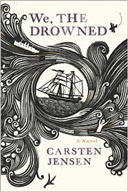 |
We, the Drowned, by Carsten Jensen We, the Drowned is the story of the people of the seafaring town of Marstal, Denmark, from the mid-1800s to the end of World War II. Many of the title’s “we” indeed drowned, lost at sea in all the various ways men die in that inhospitable environment. Carsten Jensen tells the story from the same point of view: that of the “we” of the title, the collective voice of the men and women of Marstal, past and present. This is a fresh approach, at least to me, and I found myself responding to it with a smile. Two examples:
Individual characters stand out from the collective, serving as generational focal points as the story moves forward in time. Not all of these individuals are men … the story is strongly about the women of Marstal as well, particularly Karla Friis, a widowed mother who becomes an influential shipowner and then uses her power to systematically dismantle the shipping industry that killed her husband and took her son Knut Eric away. If you’re a fan of sea stories, you’ll find plenty of them in this novel. If you’re a student of modern history, you’ll be fascinated to see WWI and WWII from the eyes of the Danes. If you just love good fiction, you’ll want to add We, the Drowned to your library. ——————– I have just one complaint, and it is not with Carsten Jensen, the translator, or the novel itself. It is with the staggering number of typos in my Nookbook version of the novel. I’m sure the publisher of We, the Drowned, Houghton Mifflin Harcourt, edited the manuscript for the hardcover version. But when they converted it for electronic readers, they clearly failed to look at it again before releasing it. Well, stuff happens during the conversion process, and the electronic version I’m reading is full of errors: in addition to missing words here and there, on almost every page there are superfluous letters and characters in the spaces between words. Like E this, or ‘ this. This is not trivial. This new-release Nookbook is priced at more than $15. For that kind of money, readers shouldn’t have to stumble over typographical errors every page or two. What’s keeping major publishers from proofreading books after the electronic reader conversion process? The price of a day’s wages for a single copy editor? How much could that cost? A hundred bucks? Less than that? No one would put up with errors like these in a hardcover or paperback book. We shouldn’t put up with it in e-books, either. When I Google “typos in e-books” I get over 200,000 results with titles like “too many errors and typos in Kindle e-books,” and “lousy proofreading in e-books.” One member of a B&N Nookbook forum says he writes down every typo and formatting error he encounters, with the page numbers on which they occur, and submits them to the publishers. To date, he says, he’s received not a single response. Most of these complaints date back at least a year. It’s a known issue, one the booksellers and publishers are certainly well aware of. Why hasn’t it been fixed? |
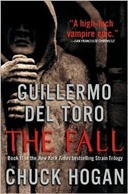 |
The Fall (Strain Trilogy #2), by Guillermo del Toro & Chuck Hogan In my review of The Strain, the first book in this series, I said that it started off well but quickly degenerated into an illogical mess. The Fall, the second book of a planned trilogy, starts in the illogical mess phase, so where does it go from there? Into an extended setup for volume number three, of course. The story is horrific and intrinsically interesting … one of the world’s seven vampire masters has come to America and unleashed an exponentially-expanding plague of vampirism. But del Toro and Hogan keep the horror in the background, focusing instead on three or four unlikely characters who are clearly destined to save humanity in volume three. This editorial decision mutes the story’s main thrill, and instead of reading a truly scary vampire thriller, I felt like I was reading just another airport bookshop thriller. Worth reading, but not worth buying. Borrow it from the library instead. |
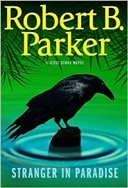 |
Stranger in Paradise (Jesse Stone Series #7), by Robert B. Parker I’m a huge fan of the Jesse Stone movies with Tom Selleck. Stranger in Paradise, though, is my first Jesse Stone book. To those who’ve seen the movies but not read the books, let me whet your curiosity by telling you that the movies get Jesse Stone’s character, mannerisms, and dialog just about right … there, now don’t you want to read the books too? With the movies under my belt I felt quite at home in this book, and though the literary Jesse Stone is somewhat younger than his cinematic counterpart, my mental image of Tom Selleck went right along with the story. This is in no way a serious review, just as this Jesse Stone novel was in no way a serious book. It’s not even much of a mystery. What it is is a light read, double-spaced to make it appear longer than it actually is, a book you can easily finish in a day. But light and un-serious though it may be, it’s great fun, and Jesse Stone movie fans will find themselves running out to buy or borrow all the books. |
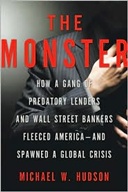 |
The Monster: How a Gang of Predatory Lenders and Wall Street Bankers Fleeced America–and Spawned a Global Crisis, by Michael W. Hudson With regard to books on the sub-prime meltdown of 2008 and the damage it did to the American and global economy, I have previously read and reviewed Michael Lewis’ The Big Short: Inside the Doomsday Machine. Lewis’ book focused on the details and nature of the complex financial instruments being traded by high-level financial executives on Wall Street, and a small set of amoral entrepreneurs who clearly saw the coming disaster and took advantage of it to line their own pockets. Michael Hudson, in The Monster, focuses instead on the predatory lenders who built empires selling the sub-prime mortgages themselves, the CEOs of companies like AmeriQuest and FAMCO, and to a lesser extent the bond traders on Wall Street who backed the fraudsters, Lehman Brothers in particular. Not surprisingly, one learns that the CEOs and managers of predatory lending companies are assholes to a man, boiler room operators who relentlessly flogged their salesmen to produce more and yet more, cold-hearted greedheads who would fleece impoverished grandmothers on Social Security and think nothing of it. When it comes to the deep-pocketed bond traders like Lehman Brothers, Hudson shows that it was always perfectly clear to them what sort of crooked operators they were crawling into bed with; again, no one gave a shit about anything but money. Hudson also describes the innumerable investigations of sub-prime mortgage lenders and their Wall Street backers that were mounted around the country, some successful in getting small settlements for naive borrowers who had their homes taken from them, most not. The Monster is quite readable, and easier to understand than The Big Short. It’s a depressing story, and one suspects little has changed in the wake of the sub-prime debacle. |
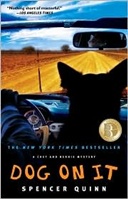 |
Dog on It (Chet and Bernie Series #1), by Spencer Quinn A friend and fellow dog lover loaned me this mystery, the gimmick of which is that it’s narrated by a private eye’s canine sidekick. But to say the Bernie & Chet mysteries are based on a gimmick is to give only half the picture. Yes, Spencer Quinn allows Chet, private eye Bernie’s trained police dog, to narrate the story, and yes, that’s a gimmick. But Chet is a well-drawn character and after only a little initial resistance, I bought into the conceit. Chet is a dog through and through, constantly distracted by scents, food, the sounds of other dogs barking, the promise of sex, the thrill of the chase. But he’s a good judge of character, and given the limitations of a Chet’s canine intelligence and memory (which writer Quinn scrupulously observes), he’s Bernie’s loyal partner and an active participant in solving cases. It’s all very well done, and if you’re a sucker for well-written dog books like The Story of Edgar Sawtell and The Art of Racing in the Rain (reviewed here), you’ll be a sucker for Dog on It and other Bernie & Chet mysteries. |
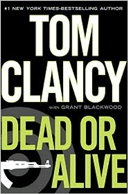 |
Dead or Alive, by Tom Clancy A friend of mine writes Tom Clancy-esque fiction; novels that revolve around covert military action, politics, foreign policy, and hyper-effective individual characters who move the great game along and in the end almost single-handedly save the day. A few months ago he told me Tom Clancy was, at last, about to publish his first military-espionage thriller in years, and that he and other writers like him hoped Clancy would reinvigorate a literary market that, once thriving, was now moribund. Well, Clancy’s book is out, and I must say the first couple of chapters made me think Clancy was on his way to recapturing the glory of The Hunt for Red October. Alas, he didn’t keep the momentum going, and what started out as a strong soldierly adventure story turned into a mish-mash of Navy SEAL and Army Green Beret hero-worship, rambling non-plot-related page-filler chitchat, clumsy dialog insertions meant to explain military concepts and spell out acronyms, a five-page political speech from Jack Ryan that was so paternalistic and disconnected from reality I thought Clancy was channeling Ayn Rand, and an impossibly successful counter-operation against Al Qaeda and Osama bin Laden. I mean, really? Jack Ryan’s son, with no military or special operations training whatsoever, is accepted into an über-elite clandestine special operations organization and sent out on “wet” missions, where he proves to be twice the man James Bond was? Uh, sure. White Americans walk around freely after dark in densely-populated ghetto neighborhoods in Tripoli and São Paulo, then, heavily outnumbered, take on and effortlessly kill armed and trained Al Qaeda members? All without alerting a single local? Right. One etiolated IT nerd cracks every enemy code, every time, always at the last minute? Sure, happens all the time. At least Tom Clancy had the decency to kill off one good guy, but then again, don’t dictators display a similar decency by seeing to it they win their sham elections with 98 or 99% of the vote, never 100%? I’m always puzzled when writers attempt to disguise the real world when they are, in fact, writing about the real world. Why did James Michener, in his novel Space, feel he had to replace Florida with a fictional state? And why does Clancy feel he can’t name Al Qaeda or Osama bin Laden, calling them instead the URM and Emir something-or-other? Was he worried Osama might sue? Look, I flew fighters for 24 years, and I worship the military, but this is military-worship carried too far, and what the whole book comes down to is a cheesy revenge fantasy about getting even with the men who hit us on 9/11/2001. If your first Tom Clancy book was The Hunt for Red October, I think you’ll be disappointed in this one. If you’re new to Clancy, on the other hand, and Dead or Alive is your first Jack Ryan novel, you’ll probably love it. As for my writer friend, I think he’ll get his wish … Dead or Alive will sell a lot of copies, and reinvigorate the military-espionage thriller market. |